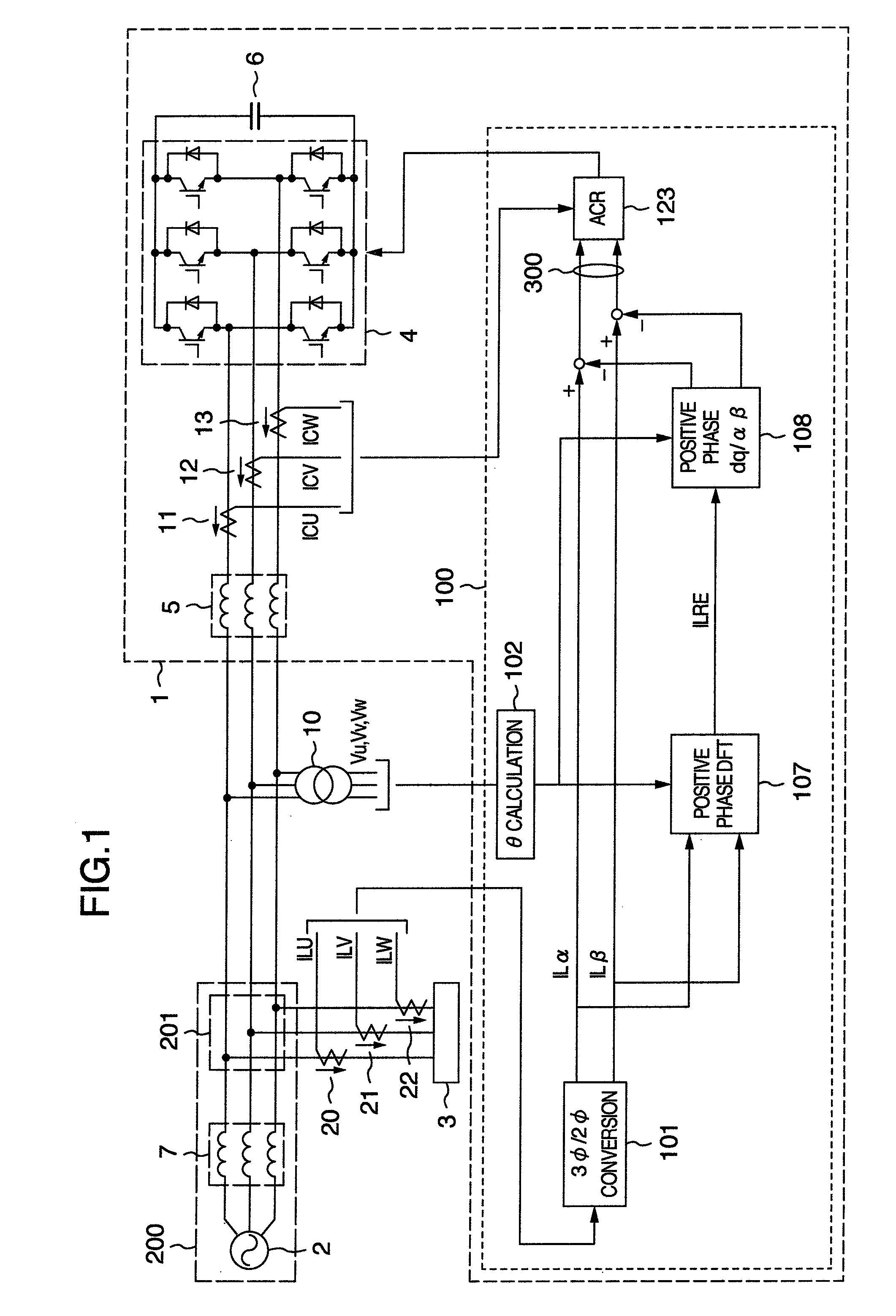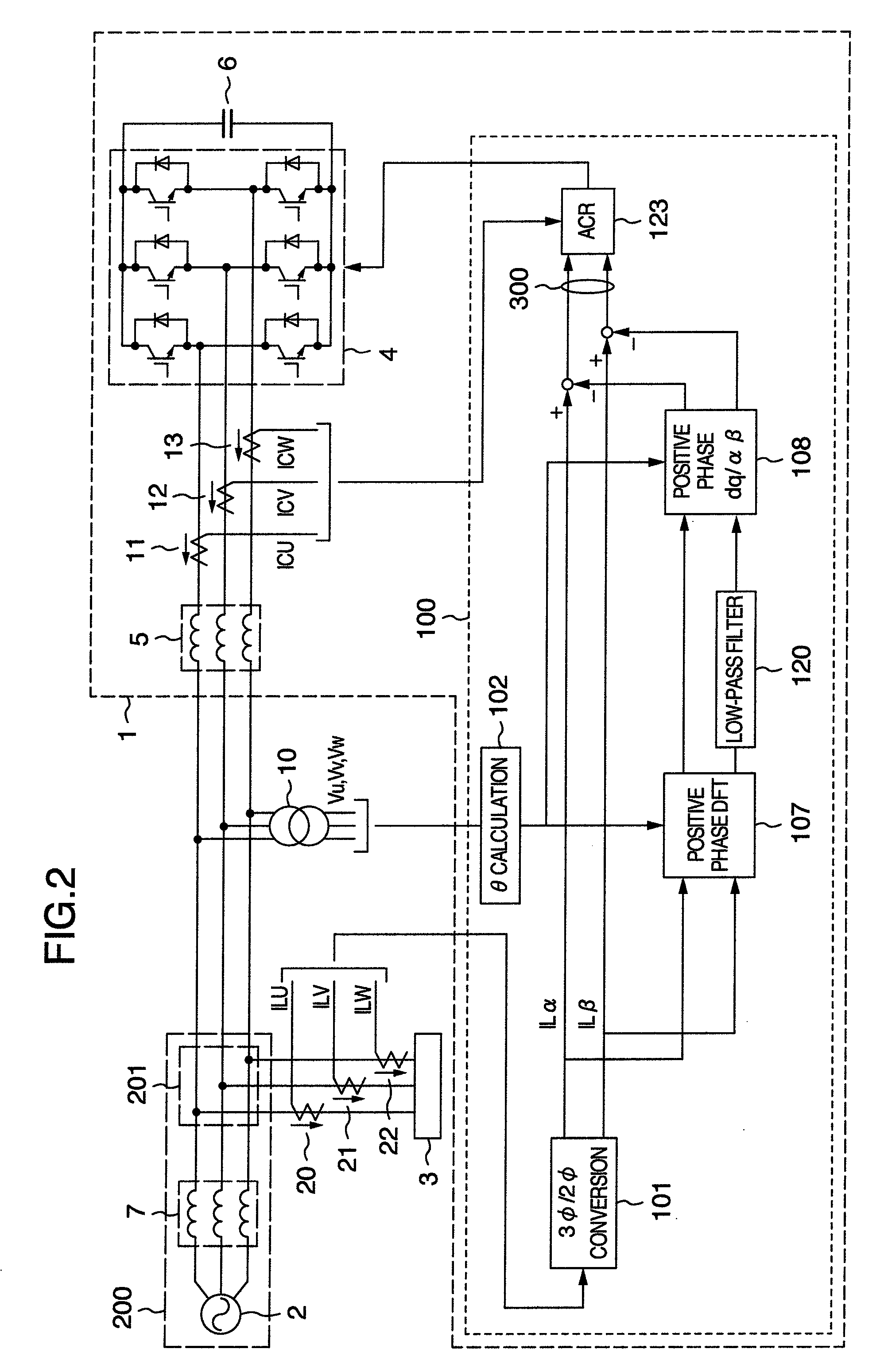Power converting device and method for controlling the same
- Summary
- Abstract
- Description
- Claims
- Application Information
AI Technical Summary
Benefits of technology
Problems solved by technology
Method used
Image
Examples
embodiment 1
[0017]A first embodiment in accordance with the present invention will be described referring to FIG. 1.
[0018]As shown in FIG. 1, a power converting device 1 in accordance with the first embodiment is connected to a load 3 and an AC system 200 of a commercial power system at a connecting point 201. In FIG. 1, the AC system 200 is represented by an AC power supply 2 and a system impedance 7. The system impedance 7 means power line impedance and transformer impedance. When the load current fluctuates, the voltage drop occurring in the system impedance 7 also fluctuates, by which voltage fluctuation occurs at the connecting point 201 of the load 3 and the AC system 200. The power converting device 1 of this embodiment reduces and suppresses the voltage fluctuation at the connecting point and the system current fluctuation which are caused by the load current fluctuation.
[0019]The power converting device 1 of this embodiment includes a main circuit unit and a control calculation unit 10...
embodiment 2
[0024]While the current instruction value 300 of the power converting device 1 is calculated in the first embodiment by subtracting the positive phase active fundamental current from the load current, the current instruction value 300 of a power converting device 1 of a second embodiment is calculated by subtracting not only the positive phase active fundamental current but also low-frequency components (frequency components sufficiently lower than the fundamental frequency) of the positive phase reactive current amplitude from the load current.
[0025]For example, in cases where fluctuation compensation in a relatively high-frequency range (over several Hz) is important, the output of the power converting device 1 against high-frequency fluctuations can be relatively increased by reducing the compensation for low-frequency components (e.g. under 1 Hz) of the reactive current amplitude.
[0026]FIG. 2 is a schematic diagram showing a principal part of the power converting device 1 in acc...
embodiment 3
[0030]While the current instruction value 300 of the power converting device 1 is obtained by subtracting the positive phase active fundamental current and the low-frequency components of the positive phase reactive fundamental current from the load current (ILα, ILβ) in the second embodiment, the current instruction value 300 of a power converting device 1 in accordance with a third embodiment is calculated by subtracting not only the positive phase active fundamental current and the low-frequency components of the positive phase reactive fundamental current but also low-frequency components of negative phase currents from the load current (ILα, ILβ).
[0031]In cases where the load 3 is an imbalanced load and fluctuation compensation to relatively high-frequency components (over several Hz) is important, the output of the power converting device 1 against high-frequency fluctuations can be relatively increased by reducing the compensation to negative phase low-frequency components.
[0...
PUM
 Login to View More
Login to View More Abstract
Description
Claims
Application Information
 Login to View More
Login to View More - R&D
- Intellectual Property
- Life Sciences
- Materials
- Tech Scout
- Unparalleled Data Quality
- Higher Quality Content
- 60% Fewer Hallucinations
Browse by: Latest US Patents, China's latest patents, Technical Efficacy Thesaurus, Application Domain, Technology Topic, Popular Technical Reports.
© 2025 PatSnap. All rights reserved.Legal|Privacy policy|Modern Slavery Act Transparency Statement|Sitemap|About US| Contact US: help@patsnap.com



